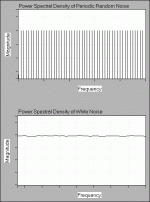After learning about pink noise I'm extremely confused about frequency response. Would a flat frequency response be flat with pink noise applied or white noise applied?
Frequency response (as applied to say an amplifier) is a measure of the limits in frequency at which the output falls by some specified amount.
White noise and pink noise as applied to an amplifier are considered signal sources and as such do not affect the frequency response of the device they are applied to.
To determine frequency response a swept sine wave is normally used starting at a low frequency and increasing to a high one, not noise, and the output measured and the point at which the output falls by say 1 or 3 db would be the frequency response limits.
So you might have an amplifier with a response of 18Hz to 26Khz -3db. That would be a frequency response.
White noise and pink noise as applied to an amplifier are considered signal sources and as such do not affect the frequency response of the device they are applied to.
To determine frequency response a swept sine wave is normally used starting at a low frequency and increasing to a high one, not noise, and the output measured and the point at which the output falls by say 1 or 3 db would be the frequency response limits.
So you might have an amplifier with a response of 18Hz to 26Khz -3db. That would be a frequency response.
Right I understand this but a decibel is a logarithmic function. So wouldn't white noise increase in dB while pink noise would be flat?
No. Decibels have nothing to do with it. As the graph shows, White Noise has equal amplitude across the spectrum. Pink noise has more low frequency amplitude than high frequency amplitude.
Okay that's what I originally thought, but then why would a flat frequency response (flat with white noise) be ideal for a speaker if this would accentuate the perceived noise of high frequency response?
Wouldn't a flat response in reference to pink noise be better?
Wouldn't a flat response in reference to pink noise be better?
Right! This is exactly what I'm talking about (using a RTA)
I just dont understand how an RTA would see pink noise as "flat" when a loudspeaker has a "flat" frequency response. Shouldn't the RTA see pink noise as -3dB an octave?
I'm just completely and utterly confused about this.
I just dont understand how an RTA would see pink noise as "flat" when a loudspeaker has a "flat" frequency response. Shouldn't the RTA see pink noise as -3dB an octave?
I'm just completely and utterly confused about this.
The essence of measuring frequency response is to know (or measure) what you are putting in, measure what you are getting out then calculate the ratio. If a unit is flat then it is still flat whatever you put in.
The essence of measuring frequency response is to know (or measure) what you are putting in, measure what you are getting out then calculate the ratio. If a unit is flat then it is still flat whatever you put in.
Absolutely correct!
I re-read the original post and realized that I made some assumptions which may not have been correct.
It is always difficult to understand what is confusing someone else. If the OP could explain to us exactly what is confusing him, then he wouldn't be confused! So we could only help him if he didn't need help.
It's always been a bit fuzzy to me too! White noise has equal power at every frequency. If you measure it with something having a constant bandwidth filter, like a traditional spectrum analyzer, you'll get a flat response curve. I assume that means with an FFT as well. If you use something where the filter bandwidth varies, like a 1/3 octave analyzer, the result will rise at 3 dB per octave. This is because you're working in octaves, not Hz, and each filter window is taking a different sized "chunk" of the energy.
If you filter the white noise such that it rolls off at 3 dB per octave, it will compensate for the way a 1/3 octave analyzer works, and give you a flat result.
Measuring a speaker, it's a matter of comparing the input to the output, so feed it white noise if you're measuring with a spectrum analyzer. Feed it pink noise if you're using an octave analyzer. Many devices can be set to measure either way (the free Visual Analyser for example) so excite the DUT as needed.
No doubt if I have this wrong, somebody will correct it!
If you filter the white noise such that it rolls off at 3 dB per octave, it will compensate for the way a 1/3 octave analyzer works, and give you a flat result.
Measuring a speaker, it's a matter of comparing the input to the output, so feed it white noise if you're measuring with a spectrum analyzer. Feed it pink noise if you're using an octave analyzer. Many devices can be set to measure either way (the free Visual Analyser for example) so excite the DUT as needed.
No doubt if I have this wrong, somebody will correct it!
- Status
- Not open for further replies.
- Home
- Design & Build
- Equipment & Tools
- Confused about measuring frequency responce
